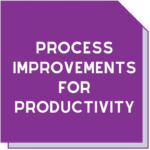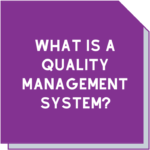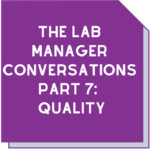Is Quality still the key to success?
 If someone were to ask whether your business had a Quality focus, how would you answer? Would it be an enthusiastic, “Well of course! Quality is at the core of everything we do!”
If someone were to ask whether your business had a Quality focus, how would you answer? Would it be an enthusiastic, “Well of course! Quality is at the core of everything we do!”
Or would it be more like, “Sure. We’ve got that document thingy we follow. We put it in a glass cabinet, so we see it all the time!”
A Quality Management System (QMS) brings many benefits. One of the main benefits is consistency of outcomes of processes. A QMS can also lead to greater efficiency and less waste.
If your business has a QMS in place, it’s probably been developed with a particular ISO standard in mind.
We’ll take a look at the bedrock of many management system standards- ISO 9001. It’s upon this rock that other standards like ISO/IEC 17025, ISO 15189, and ISO/IEC 17020 are built.
What is ISO 9001?
This standard sets out the criteria for a QMS and can be used by any organisation regardless of its size or activity. According to ISO, there are over one million companies and organisations across 170 countries that are certified to ISO 9001.
ISO 9001 provides a framework for businesses to consistently deliver products and services that fulfil customer needs. The framework maintains customer expectations through a structure that allows for continuous improvement.
This means that businesses can improve productivity and potentially expand operations without affecting the quality of their services or products. Happy customers mean referrals leading to business growth and increased profits.
Sounds like magic, doesn’t it!
Well, it’s not exactly magic but when your systems are in place and all is working as it should, it certainly feels good!
The seven elements
The QMS family of ISO standards are based on seven quality management principles. These principles are:
- Customer focus
- Leadership
- Engagement of people
- Process approach
- Improvement
- Evidence-based decision making
- Relationship management
These elements are described by ISO as ‘a set of fundamental belief, norms, rules and values that are accepted as true and can be used as a basis for quality management’. They are the foundation on which to build an organisation’s performance standard and improvement.
There are many frameworks for quality management systems, ranging from Lean Six Sigma (a quality improvement framework), the ISO 9000 family of standards, and business excellence frameworks. All require commitment from management, time, attention, and engagement.
Like all Quality frameworks, one of the primary principles that ISO 9001 is built upon is continual improvement.
Gurus in Quality have developed tools to help businesses realise the benefits of the adoption of a QMS. Some focus on “how to do” continual improvement. Others deal with how knowledge is managed, while some drive to help leaders get the right people doing the right thing at the right time.
So, what are these tools and how do they help improve your QMS? Let’s look at a couple:
“In God we trust. All others must bring data.”
 W. Edwards Deming was spot on. Because without data, it’s not analysis, it’s just a conversation.
W. Edwards Deming was spot on. Because without data, it’s not analysis, it’s just a conversation.
Data shows you what you need to improve and then when you’ve made those changes, whether those improvements worked.
There are tools you can use to gather and analyse this data. These include records that allow us to gather data, while scatter diagrams, Pareto analysis, histograms, and control charts help with the analysis of that data. We’ll explore some of these tools in another article.
To improve a process, you first need to understand it. Mapping out the process in a flowchart gives a clear, graphical depiction for everyone involved in the process. Developing a flowchart gives you the opportunity to find blockages and where time and resources are wasted.
And there are other benefits to mapping processes.
Unlocking knowledge
Every organisation has processes it follows to do its work. Often the same process is carried out each time we do a specific task. For example, when we interact with customers, make a certain product, or deliver a service. Even if it’s bespoke for each client, at the core, the same process occurs. But how do you get everyone doing the right steps of a process and produce a consistent output? That’s where knowledge management comes to the fore.
One of the main benefits of mapping a process is that you get to share knowledge and experience residing in your head (or department leaders’ heads).
Putting all the pieces of a process together helps people make sense of lots of information. As a side benefit, it can also improve communication among the team.
A QMS will help your business to organise these processes and ensure the customer’s requirements are met.
Good quality documentation
 The phrase “It’s not done until it’s documented” is probably a familiar one in labs. The fact is labs are full of documents (some of which are probably more useful than others!).
The phrase “It’s not done until it’s documented” is probably a familiar one in labs. The fact is labs are full of documents (some of which are probably more useful than others!).
We’ve written previously about documentation in your lab and how to create good documents. Think of the relationship between your policies, processes, procedures, and records as a tree. The policies are the roots because they form the base for all functions. The processes are the trunk, and the procedures are the branches. Documents should be clear, accessible and fit for purpose.
Remember, certification and accreditation bodies will ask to see your Quality Manual, Quality Policy, and procedures. You’ll also need to demonstrate how your documents are stored, shared, updated, and controlled.
If you need some help with document control we’ve got an article about that too!
How do improvements happen?
 The plan phase of the Deming Circle (plan-do-check-act) seems the logical place for us to find improvements. Follow up your root cause investigations and analysis with prevention and corrective actions. This will lead to improvements and hopefully, innovations.
The plan phase of the Deming Circle (plan-do-check-act) seems the logical place for us to find improvements. Follow up your root cause investigations and analysis with prevention and corrective actions. This will lead to improvements and hopefully, innovations.
Train and educate your staff in tools and methodologies to achieve improvements. If they don’t know how to identify and implement improvements, then you could find your lab constantly in a vicious cycle of woe.
Implementing improvements should increase process performance, organisational capabilities, and customer satisfaction. They should also enhance the ability to anticipate and react to both internal and external risks and opportunities. Otherwise, there is little point in doing them. Change for change’s sake is not required or recommended!
Track and review any improvement projects. Importantly, acknowledge and share the results of these projects across the business.
We can help!
If your organisation has gone down the path of accreditation or certification, this probably all sounds very familiar. But that doesn’t mean you and your staff understand the elements of ISO 9001 and its sister standards or how they apply if you’re working in a lab.
We have tailored our Understanding ISO 9001 training course for people working in labs and in the science and technology fields. Unlike other courses in ISO 9001, we’ll take you through all the elements of ISO 9001, using real world case studies that apply to labs and those working in science and technology. Or our ISO/IEC 17025 Unpacked course might be just the thing you need.
You could, with some effort and time, learn the standard for yourself and work out how to apply it to your business. But you need to ask yourself if this is the most effective use of your time? And the answer, usually, will be no.
By using a consultant like MAS Management Systems to help you with ISO 9001, ISO/IEC 17025, ISO 15189 or ISO/IEC 17020 implementation you have someone on tap who can share their experience and insights, saving your time, money, and sanity.
Remember, you don’t have to do this alone!
Download the article Is quality still the key to success?





